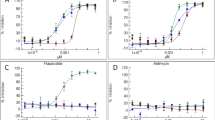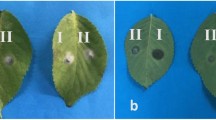Abstract
Alternaria species are common pathogens of fruit and vegetables able to produce secondary metabolites potentially affecting human health. Twenty-nine isolates obtained from cabbage, cauliflower, wild and cultivated rocket were characterized and identified based on sporulation pattern and virulence; the phylogenetic analysis was based on the β-tubulin gene. Isolates were identified as A. alternata, A. tenuissima, A. arborescens, A. brassicicola and A. japonica. Pathogenicity was evaluated on plants under greenhouse conditions. Two isolates showed low level of virulence on cultivated rocket while the other isolates showed medium or high level of virulence. Isolates were also characterized for their mycotoxin production on a modified Czapek-Dox medium. Production of the five Alternaria toxins, tenuazonic acid, alternariol, alternariol monomethyl ether, altenuene and tentoxin were evaluated. Under these conditions, about 80% of the isolates showed the ability to produce at least one mycotoxin.



Similar content being viewed by others
References
Andersen, B., Krøger, E., & Roberts, R. G. (2002). Chemical and morphological segregation of Alternaria arborescens, A. infectoria and A. tenuissima species-groups. Mycological Research, 106, 170–182.
Andersen, B., Sørensen, J. L., Nielsen, K. F., van den Ende, B. G., & de Hoog, S. (2009). A polyphasic approach to the taxonomy of the Alternaria Infectoria species-group. Fungal Genetics and Biology, 46, 642–656.
Aneja, J. K., Agarwal, A. A., & Agnihorti, A. A. (2014). Inter and intra-specific diversity in Alternaria species infecting oilseed brassicas in India. Journal of Oilseed Brassica, 5, 102–117.
Bessadat, N., Simoneau, P., Benichou, S., Setti, B., Kihal, M., & Henni, D. E. (2014). Morphological, physiological and pathogenic variability of small-spore Alternaria sp. causing leaf blight of Solanaceous plants in Algeria. African Journal of Microbiology Research, 8, 3422–3434.
Bottalico, A., & Logrieco, A. (1998). Toxigenic Alternaria species of economic importance. In K. K. Sinha & D. Bhatnagar (Eds.), Mycotoxins in agriculture and food safety (pp. 65–108). New York: Marcel Dekker.
Brzonkalik, K., Herrling, T., Syldatk, C., & Neumann, A. (2011). The influence of different nitrogen and carbon sources on mycotoxin production in Alternaria alternata. International Journal of Food Microbiology, 147, 120–126.
CABI. (2007). Crop protection compendium (2007th ed.). Wallingford: CABI International.
Desjardins, A. E., Spencer, G. F., Plattner, R. D., & Beremand, M. N. (1989). Furanocoumarin phytoalexins, trichothecene toxins, and infection of Pastinaca sativa by Fusarium sporotrichioides. Phytopathology, 79, 170–175.
Ellis, M. B. (1971). Dematiaceous hyphomycetes. Kew, UK: Commonwealth Mycological Institute.
Ellis, M. B. (1976). More Dematiaceous Hyphomycetes. Kew, UK: Commonwealth Mycological Institute.
Farr, D. F., Rossman, A.Y. (2016). Fungal databases - fungal databases, systematic mycology and microbiology laboratory. ARS, USDA.
Gannibal, P. B., Orina, A. S., Mironenko, N. V., & Levitin, M. M. (2014). Differentiation of closely related species, Alternaria solani and A. tomatophila, by molecular and morphological features and aggressiveness. European Journal of Plant Pathology, 139, 609–623.
Garibaldi, A., Gilardi, G., Bertoldo, C., & Gullino, M. L. (2011). First report of leaf spot of wild (Diplotaxis tenuifolia) and cultivated (Eruca vesicaria) rocket caused by Alternaria japonica in Italy. Plant Disease, 95, 1316.
Geisen, R., Graf, E., & Schmidt-Heydt, M. (2015). HogA and PacC regulated alternariol biosynthesis by Alternaria alternata is important for successful substrate colonization. Acta Horticulturae, 1144, 141–148.
Gilardi, G., Demarchi, S., Ortu, G., Gullino, M. L., & Garibaldi, A. (2015). Occurrence of Alternaria japonica on seeds of wild and cultivated rocket. Journal of Phytophatology, 163, 419–422.
Graf, E., Schmidt-Heydt, M., & Geisen, R. (2012). HOG MAP kinase regulation of alternariol biosynthesis in Alternaria alternata is important for substrate colonization. International Journal of Food Microbiology, 157, 353–359.
Häggblom, P., & Niehaus, W. G. (1986). Light effects on polyketide metabolism in Alternaria alternata. Experimental Mycology, 10, 252–255.
Häggblom, P., & Unestam, T. (1979). Blue light inhibits mycotoxin production and increases total lipids and pigmentation in Alternaria alternata. Applied and Environmental Microbiology, 38, 1074–1077.
Hasan, H. A. (1996). Alternaria mycotoxins in black rot lesion of tomato fruit: Conditions and regulation of their production. Acta Microbiologica et Immunologica Hungarica Journal, 43, 125–133.
Humpherson-Jones, F. M. (1989). Survival of Alternaria brassicae and Alternaria brassicicola on seed debris of oilseed rape and cabbage. Annals of Applied Biology, 115, 45–50.
Humpherson-Jones, F. M. (2007). The incidence of Alternaria spp. and Leptosphaeria maculans in commercial brassica seed in the United Kingdom. Plant Pathology, 34, 385–390.
Humpherson-Jones, F. M., & Maude, R. B. (1982). Studies on the epidemiology of Alternaria brassicicola in Brassica oleracea seed production crops. Annals of Applied Biology, 100, 61–71.
Joly, P. (1964). Le genre Alternaria: recherches physiologiques, biologiques et systématiques. Encyclopédie Mycologique, 33, 1–250.
Kohl, J., van Tongeren, C. A. M., Groenenboom-de Haas, B. H., van Hoof, R. A., Driessen, R., & van der Heijden, L. (2010). Epidemiology of dark leaf spot caused by Alternaria brassicicola and A. brassicae in organic seed production of cauliflower. Plant Pathology, 59, 358–367.
Kolte, S.J., Awasthi, R.P., Vishwanath (1987). Assessments of yield losses due to Alternaria blight in rapeseed and mustard. Indian Phytopathology, 40, 209–211.
Lauren, S. J., & Fadwa, A. T. (2008). Factors affecting mycotoxin production in fruits. In R. Barkai-Golan & N. Paster (Eds.), Mycotoxins in fruit and vegetables (pp. 75–104). London: Academic Press Is an Imprint of Elsevier.
Lawrence, D. P., Gannibal, P. B., Peever, T. L., & Pryor, B. M. (2013). The sections of Alternaria: Formalizing species-groups concepts. Mycologia, 105, 530–546.
Mac Kinon, S. L., Keifer, P., & Ayer, W. A. (1999). Components from the phytotoxic extracts of Alternaria brassicicola, a black spot pathogen of canola. Phytochemistry, 51, 215–221.
Maude, R. B., & Humpherson-Jones, F. M. (1980). Studies on the seed-borne phases of dark leaf spot (Alternaria brassicicola) and grey leaf spot (Alternaria brassicae) of brassicas. Annals of Applied Biology, 95, 311–327.
Neergaard, P. (1945). Danish Species of Alternaria and Stemphylium. Copenhagen: E. Munksgaard.
O'Donnell, K., & Cigelnik, E. (1997). Two divergent intragenomic rDNA ITS2 types within a monophyletic lineage of the fungus Fusarium are nonorthologous. Molecular Phylogenetics and Evolution, 7(1), 103–116.
Ostry, V. (2008). Alternaria mycotoxins: An overview of chemical characterization, producers, toxicity, analysis and occurrence in foodstuffs. World Mycotoxins Journal, 1, 175–188.
Peever, T. L., Salimath, S. S., Su, G., Kaiser, W. J., & Muehlbauer, F. J. (2004). Historical and contemporary multilocus population structure of Ascochyta rabiei (teleomorph: Didymella rabiei) in the Pacific Northwest of the United States. Molecular Ecology, 13(2), 291–309.
Peruch, L. A. M., Michereff, S. J., & Araújo, I. B. (2006). Survey of the intensity of Alternaria black spot and black rot on brassica species under organic farming systems in Pernambuco and Santa Catarina states, Brazil. Horticultura Brasileira, 24(4), 464–469.
Pitt, J. I., & Hocking, A. D. (1997). Fungi and Food Spoilage. Sydney: Academic Press. doi:10.1007/978-1-4615-6391-4.
Polizzotto, R., Andersen, B., Martini, M., Grisan, S., Assante, G., & Musetti, R. (2012). A polyphasic approach for the characterization of endophytic Alternaria strains isolated from grapevines. Journal of Microbiological Methods, 88, 162–171.
Rahimloo, T., & Ghosta, Y. (2015). The occurrence of Alternaria species on cabbage in Iran. Žemdirbystė (Agriculture), 102(3), 343–350.
Reis, A., & Boiteux, L. S. (2010). Alternaria species infecting Brassicaceae in the Brazilian neotropics: Geographical distribution, host range and specificity. Journal of Plant Pathology, 92(3), 661–668.
Rossman, S. N., Cernoch, P. L., & Davis, J. R. (1996). Dematiaceous fungi are an increasing cause of human disease. Clinical Infectious Diseases, 22, 73–80.
Sanchis, V., & Magan, N. (2004). Environmental conditions affecting mycotoxins. In N. Magan & M. Olsen (Eds.), Mycotoxins in food: Detection and control (pp. 174–189). Cambridge: Woodhead Publishing.
Siciliano, I., Ortu, G., Gilardi, G., Gullino, M. L., & Garibaldi, A. (2015). Mycotoxin production in liquid culture and on plants infected with Alternaria spp. isolated from rocket and cabbage. Toxins, 7, 743–754.
Simmons, E. G. (1992). Alternaria taxonomy: current status, viewpoint, challenge. In J. Chelkowski & A. Viskonti (Eds.), Alternaria: Biology, Plant Diseases and Metabolites (pp. 1–35). Amsterdam: Elsevier.
Simmons, E. G. (1995). Alternaria themes and variations. Mycotaxon, 55, 55–163.
Simmons, E. G. (2007). Alternaria: An Identification Manual. St Paul: APS PRESS.
Simmons, E. G., & Roberts, R. G. (1993). Alternaria themes and variations. Mycotaxon, 48, 109–140.
Singh, R. C., Mohan, C., & Sharma, V. K. (2012). Morphological and pathological variations in isolates of Aletrnaria brassicae causing leaf blight of rapeseed and mustard. Plant Disease Resistance, 27, 22–27.
Stinson, E. E., Bills, D. D., Osman, S. F., Siciliano, J., Ceponis, M. J., & Heisler, E. G. (1980). Mycotoxin production by Alternaria species grown on apples, tomatoes and blueberries. Journal of Agricultural and Food Chemistry, 28, 960–963.
Stinson, E. E., Osman, S. F., Heisler, E. J., Siciliano, J., & Bills, D. D. (1981). Mycotoxin production in whole tomatoes, apples, oranges and lemons. Journal of Agricultural and Food Chemistry, 29, 790–792.
Tamura, K., Dudley, J., Nei, M., & Kumar, S. (2007). MEGA4: molecular evolutionary genetics analysis (MEGA) software version 4.0. Molecular Biology and Evolution, 24(8), 1596–1599.
Thomma, B. P. H. J. (2003). Alternaria spp.: from general saprophyte to specific parasite. Molecular Plant Pathology, 4, 225–236.
Van der Waals, J. E., Korsten, L., & Slippers, B. (2004). Genetic diversity among Alternaria solani isolates from potatoes in South Africa. Plant Disease, 88, 959–964.
Verma, P. R., & Saharan, G. S. (1994). Monograph on Alternaria diseases of crucifers. Ottawa, Canada: Research Branch, Agriculture and Agri-Food Canada.
Woudenberg, J. H. C., Groenewald, J. Z., Binder, M., & Crous, P. W. (2013). Alternaria redefined. Studies in Mycology, 75, 171–212.
Woudenberg, J. H., Seidl, M. F., Groenewald, J. Z., de Vries, M., Stielow, J. B., Thomma, B. P., & Crous, P. W. (2015). Alternaria section Alternaria: Species, formae speciales or pathotypes? Studies in Mycology, 82, 1–21.
Acknowledgements
Work supported by the European Community’s Seventh Framework Programme (FP7/2007-2013) under grant agreement n. 261752, PLANTFOODSEC “Plant and Food Biosecurity, Network of Excellence”.
Author information
Authors and Affiliations
Corresponding author
Rights and permissions
About this article
Cite this article
Siciliano, I., Gilardi, G., Ortu, G. et al. Identification and characterization of Alternaria species causing leaf spot on cabbage, cauliflower, wild and cultivated rocket by using molecular and morphological features and mycotoxin production. Eur J Plant Pathol 149, 401–413 (2017). https://doi.org/10.1007/s10658-017-1190-0
Accepted:
Published:
Issue Date:
DOI: https://doi.org/10.1007/s10658-017-1190-0




